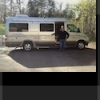
A few weeks ago we were at Mingus Park on the Oregon Coast. Mingus Park is in a really, really hilly part of the coast; there’s not much of a...
Roadtreking : The RV Lifestyle Blog - Traveling North America in a small motorhome
Source
- Read more...
- 0 comments
- 762 views

